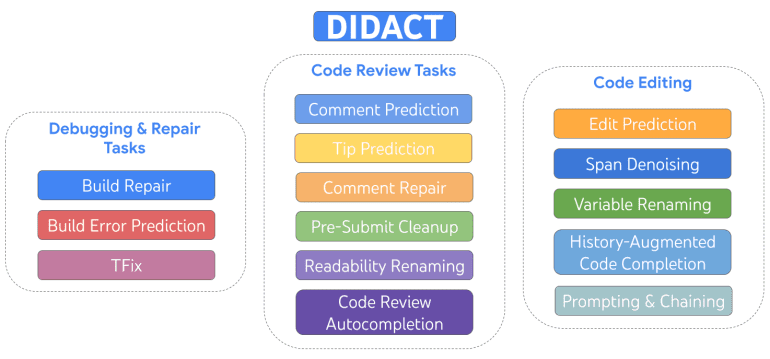- GoogleAI introduces DIDACT, a solution to streamline fixing build errors in Java development.
- DIDACT leverages machine learning (ML) to predict patches for build errors based on historical data.
- It utilizes resolution sessions to analyze code evolution from error occurrence to resolution.
- Predictive fixes are suggested in real-time within Integrated Development Environments (IDEs).
- DIDACT’s training on diverse datasets ensures accurate and safe fixes.
- Post-processing steps enhance the quality and safety of suggested fixes.
- Experimental results show significant productivity improvements without increased safety risks or bugs.
Main AI News:
GoogleAI’s breakthrough in revolutionizing the developer experience during the code build phase has been revealed. The latest research introduces Dynamic Integrated Developer ACTivity (DIDACT), a cutting-edge solution designed to alleviate the challenges developers face when fixing build errors, particularly in Java development.
In the realm of software development, the journey from code inception to repository integration involves a myriad of iterative processes, each crucial for ensuring the quality and functionality of the final product. However, one recurring hurdle that developers encounter is the arduous task of debugging build errors, which range from trivial typos to intricate issues such as generics or template errors.
DIDACT, powered by machine learning (ML), emerges as a game-changer by streamlining this cumbersome process. Leveraging ML models trained on extensive historical data comprising developers’ code changes and build logs, DIDACT employs a novel approach termed “resolution sessions.” These sessions encapsulate the sequential evolution of code, from the onset of a build error to its successful resolution.
By analyzing the code state at the time of the error alongside the subsequent fix, DIDACT ML predicts patches to rectify build errors swiftly and accurately. These predictive fixes are seamlessly integrated into developers’ workflows through their Integrated Development Environment (IDE), enabling real-time resolution with minimal disruption.
Central to DIDACT’s efficacy is its robust training on a diverse dataset of resolution sessions, encompassing a spectrum of build errors and their corresponding remedies. During deployment, the model ingests the current code state and encounters build errors, generating patches accompanied by confidence scores to guide developers effectively.
Moreover, DIDACT incorporates post-processing mechanisms, including auto-formatting and heuristic filters, to enhance the quality and safety of suggested fixes. Empirical findings from experiments underscore a statistically significant boost in productivity metrics, marked by reduced active coding time per change-list and shepherding time per change-list, alongside an uptick in change-list throughput.
Conclusion:
GoogleAI’s DIDACT breakthrough signifies a pivotal advancement in the software development market. By revolutionizing the code build fixing process with machine learning, developers can expect increased efficiency, productivity, and confidence in their workflows. This innovation has the potential to redefine industry standards and accelerate the pace of software development, driving competitiveness and innovation in the market.

